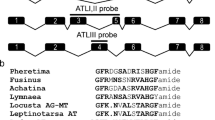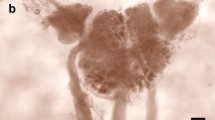Abstract
In situ hybridisation studies using a digoxigenin-labelled DNA probe encoding the Leu-callatostatin prohormone of the blowflies Calliphora vomitoria and Lucilia cuprina have revealed a variety of neurones in the brain and thoracico-abdominal ganglion, peripheral neurosecretory neurones, and endocrine cells of the midgut. With two exceptions, the hybridising cells are the same as those previously identified in immunocytochemical studies of sections and whole-mounts using Leu-callatostatin COOH-terminal-specific antisera. Within the brain and suboesophageal ganglion, there is a variety of neurones ranging from a single pair of large cells situated in the dorsal protocerebrum, to the several pairs of neurones in the tritocerebrum, some of which, in immunocytochemical preparations, can be seen to project via axons in the cervical connective to the thoracico-abdominal ganglion. In the medulla of the optic lobes, numerous small interneurones hybridise with the probe, as do clusters of similar-sized neurones close to the roots of the ocellar nerves. These results indicate that the Leu-callatostatin neuropeptides of the brain play a variety of roles in neurotransmission and neuromodulation. There are only three pairs of Leu-callatostatin-immunoreactive neurones in the thoracico-abdominal ganglion, at least two pairs of which project axons along the median abdominal nerve to provide extensive innervation of the hindgut. The Leu-callatostatin peripheral neurosecretory cells are located in close association with both nerve and muscle fibres in the thorax. In addition to neuronal Leu-callatostatin, the presence of the peptide and its mRNA has been demonstrated in endocrine cells in the posterior part of the midgut. These observations provide an example of a named brain/gut peptide in an insect.
Similar content being viewed by others
References
Bellés X, Maestro J-L, Piulachs M-D, Johnsen AH, Duve H, Thorpe A (1994) Allatostatic neuropeptides from the cockroach Blattella germanica (L.) (Dictyoptera, Blattellidae). Identification, immunolocalization and activity. Regul Pept 53:237–247
Donly BC, Ding Q, Tobe SS, Bendena WG (1993) Molecular cloning of the gene for the allatostatin family of neuropeptides from the cockroach Diploptera punctata. Proc Natl Acad Sci USA 90:8807–8811
Duve H, Thorpe A (1994) Distribution and functional significance of Leu-callatostatins in the blowfly Calliphora vomitoria. Cell Tissue Res 276:367–379
Duve H, Johnsen AH, Scott AG, Yu CG, Yagi KJ, Tobe SS, Thorpe A (1993) Callatostatins: neuropeptides from the blowfly Calliphora vomitoria with sequence homology to cockroach allatostatins. Proc Natl Acad Sci USA 90:2456–2460
Duve H, Johnsen AH, Scott AG, East P, Thorpe A (1994) [Hyp3]Met-callatostatin: identification and biological properties of a novel neuropeptide from the blowfly Calliphora vomitoria. J Biol Chem 269:21059–21066
Stay B, Chan KK, Woodhead AP (1992) Allatostatin-immunore-active neurons projecting to the corpora allata of adult Diploptera punctata. Cell Tissue Res 279:15–23
Strausfeld N J (1976) Atlas of an insect brain. Springer, Berlin Heidelberg New York
Sutherland TD (1994) Regulation of juvenile hormone synthesis in Lucilia cuprina. Ph. D. thesis. The Australian National University, Canberra
Tautz D, Pfeifle C (1989) A non-radioactive in situ hybridization method for the localization of specific RNAs in Drosophila embryos reveals translational control of the segmentation gene hunchback. Chromosoma 98:81–85
Woodhead AP, Stay B, Seidel SL, Khan MA, Tobe SS (1989) Primary structure of four allatostatins: neuropeptide inhibitors of juvenile hormone synthesis. Proc Natl Acad Sci USA 86:5997–6001
Author information
Authors and Affiliations
Rights and permissions
About this article
Cite this article
East, P.D., Thorpe, A. & Duve, H. Leu-callatostatin gene expression in the blowflies Calliphora vomitoria and Lucilia cuprina studied by in situ hybridisation: comparison with Leu-callatostatin confocal laser scanning immunocytochemistry. Cell Tissue Res 280, 355–364 (1995). https://doi.org/10.1007/BF00307808
Received:
Accepted:
Issue Date:
DOI: https://doi.org/10.1007/BF00307808




